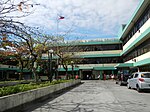The battle of Caloocan was one of the opening engagements of the Philippine–American War, and was fought between a U.S. force under the command of Arthur MacArthur Jr. and Filipino defenders commanded by Antonio Luna in 1899. American troops launched a successful attack on the Filipino-held settlement of Caloocan on February 10, which was part of an offensive planned by MacArthur Jr. Coming soon after an American victory near Manila just a few days prior, the battle once again demonstrated the military superiority enjoyed by U.S. forces over Filipino troops, yet it was not the decisive strike that MacArthur had hoped for, and the war continued to rage on for another three years.
From 1896 to 1898, Filipino revolutionaries waged an armed revolution against Spanish colonial rule. Despite providing assistance to the revolutionaries, the United States decided to annex the Philippines in the 1898 Treaty of Paris. On February 4, American troops fired on a Filipino detachment, sparking a war between the U.S. and the Philippine Republic. In the following days, American commanders in the region made plans to attack Caloocan. On February 10, American forces launched a three-hour bombardment of the settlement; immediately afterwards, a large U.S. force advanced towards Caloocan. Aided by a surprise attack, the American forces successfully stormed the city.
The capture of Caloocan placed sections of the Manila-Dagupan Railroad along with large amounts of rolling stock into the hands of U.S. forces. However, as the majority of Filipino forces were able to retreat intact and were soon able to regroup elsewhere, the battle did not have the decisive impact that American commanders had initially hoped for. On February 22, Filipino forces launched an attack on American positions on Manila, but were forced to withdraw after two days of fighting. Later, allegations that U.S. forces had summarily executed Filipino prisoners of war during the battle were investigated by a Senate Committee on the Philippines, which chose not to pursue the matter further.








